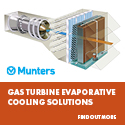FAQS
Thermal Energy Storage (TES) Systems
Q1: When should I consider utilizing a TES tank in a Turbine Inlet Cooling application?
A1: Anytime that your Turbine Inlet Cooling system is the “inlet chilling” type (chiller plant, pumps, and cooling coils), a TES tank should be considered. The tank will allow the owner/operator to drastically reduce the amount of parasitic electric loads during the inlet chilling process, and thereby maximizing the available electric power available to the grid. Incorporation of a thermal storage tank into your inlet chilling system also assists in taking advantage of excess electric grid capacity during off peak periods.
Q2: How can a TES system coupled with an inlet chilling system reduce the parasitic load?
A2: A TES tank coupled with the mechanical inlet chilling system reduces (or eliminates) the parasitic electric load of the chillers, cooling towers, and condenser pumps during the peak periods of the day. During off-peak hours (usually at night) the chiller equipment operates and chilled water is stored in the TES tank. Then during the peak periods of the day (usually the middle of the afternoon), the chilled water stored in the TES tank is circulated through coils that cool the inlet combustion air while the chiller equipment is de-energized. By cooling the inlet air for the combustion turbine, the Natural Gas power plant is able to maximize the amount of electric power available to the grid during peak periods.
Q3: How do I determine the size of the TES system?
A3: The thermal capacity and physical size of a TES system can be determined by an experienced TES consultant or TES tank manufacturer using key system variables. Three key variables are:
- The cooling load required from the tank (tons)
- Total duration the tank will be used on a peak day to cool the inlet air for the combustion in the gas turbine (hours)
- Supply and return chilled water system temperatures (°F or °C)
Q4: If I already have an inlet chilling system but it does not have a TES tank, can one be added to the system?
A4: Yes, a TES tank can be added to an existing inlet chilling system. However, an engineer experienced with integrating TES tanks into an inlet chilling system should be consulted for proper tank sizing, engineering of the ancillary mechanical and electrical components, consideration for the chilled water system hydraulics, and planning for system re-commissioning.
Q5: What increase in power output can be expected by incorporating a TES tank into my existing turbine inlet chilling system?
A5: While every system should be analyzed individually, the transfer of parasitic cooling loads from “on-peak” to “off-peak” period results in increased the net power output during critical peak demand periods. As an example, in one documented turbine inlet chilling project, utilizing a TES tank increased the power out attributable to the TIC system by 27%.
Q6: Why consider TES for TIC? Doesn’t it add complexity and cost?
A6: TES does add an additional element to a chiller-based TIC system; but TES, especially chilled water (CHW) TES, is a simple element to design and operate. Also, TES de-couples the production of cooling from the use of cooling for TIC, thus adding operational flexibility. In cases where there is a time-of-day variability in the demand for electric power or in the value of electric energy, the use of TES can reduce the capacity and capital cost of the required chiller plant installation; and in large applications, due to economy-of-scale, the added cost of the CHW TES element is generally less than the capital savings in the down-sized chiller plant. In addition, the use of TES shifts much (sometimes nearly all) of the chiller plant’s parasitic power consumption from high-value “on-peak” periods to low-cost “off-peak” periods. With net capital cost reduced, and net power during peak periods increased; the result is that TIC with TES will often have a much lower unit capital cost ($/kW) than does TIC without TES, and a lower $/kW than a CT installation with no TIC.
Q7: How does one choose between “full shift” versus “partial shift” TES?
A7: A full shift TES configuration meets 100% of the peak cooling load simply using TES, with no chillers operating during that time. A partial shift TES configuration meets the peak cooling load with a combination of TES and (a downsized) chiller installation. Generally, if the period when maximum power output is desired is short (e.g. 4 to 6 hrs/day, or less), a full shift TES can yield attractive economics. However, for longer peak periods (e.g. 8 to 10 hrs/day, or more), a partial shift TES will minimize capital cost and produce the best economics. Analysis of each specific application will determine the optimum approach.
Q8: How does TIC TES compare with other means of utility-scale Energy Storage?
A8: The need for Energy Storage (ES) in the electric power grid is well known; and that need is growing with the significantly increased use of intermittent renewable energy resources such as solar and, especially, wind power. There are several grid scale ES technologies including Pumped Hydroelectric storage (PH), and several developmental ES technologies such as; Compressed Air Energy Storage (CAES), various types of conventional and advanced electro-chemical Batteries, mechanical Flywheels, and Superconducting Magnetic Energy Storage (SMES). In comparison with these other ES options, TIC with TES has a host of advantages: near 100% round-trip energy efficiency, ease of siting (at almost any new or existing CT installation), relatively short permitting and construction periods, very low unit capital cost (generally a few hundred $/kW for the complete TIC TES installation, with the TES element being essential “free” as an add-on incorporated in a new TIC installation), long life expectancy (30+ years), and fully-proven commercial technology based on decades of successful TES use in Demand-Side Management (DSM) applications.
Q9: How widespread is the use of TIC TES?
A9: TICA member research has identified over two dozen TIC TES installations, most in North America, but also in Europe, the Middle East, Southeast Asia, and Australia, with some dating back over 25 years. As examples, in recent years eleven TIC TES installations (a representative subset of the total number of TIC TES projects), CHW TES has been used to cool the inlet air for 74 CTs (including both simple cycle and combined cycle units). Total TES capacity in those eleven projects exceeds 2 million ton-hrs, with an average storage discharge period of 7 hrs/day (and a range of 4 to 13 hrs/day). Hot weather net power enhancement from the eleven TIC TES systems ranges from 10 to 31%, totaling ~1,600 MW, with the TES contribution being over 400 MW of “dispatchable” power at an average of 7 hrs/day, for over 2,800 MWh of ES per day. There are also repeat users of TIC TES, with examples including a single utility in the US which has now employed TIC TES at four separate projects serving 12 combined cycle CTs, while a single utility in the Middle East uses TIC TES at two projects serving 50 simple cycle CTs.




